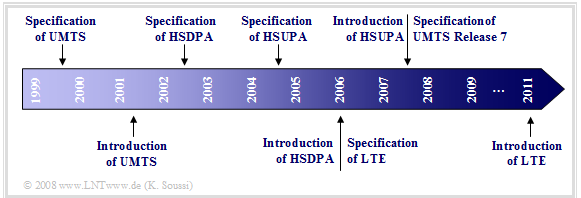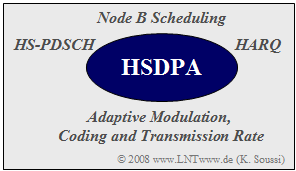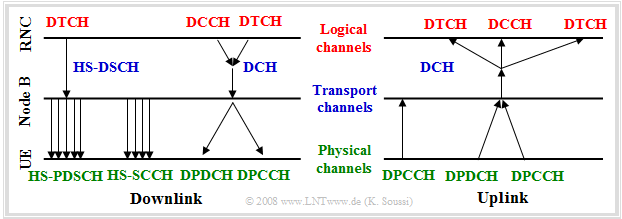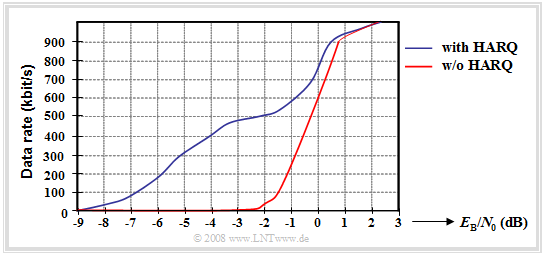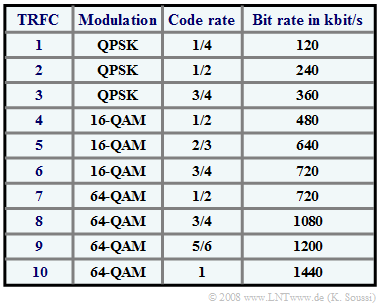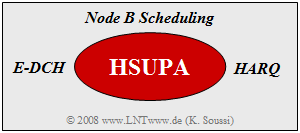Further Developments of UMTS
Contents
High–Speed Downlink Packet Access
In order to meet the increasing demand for higher data rates in mobile communications and to ensure ever better quality of service, the UMTS Release 99 standard has been further developed in five phases up to the present day $(2011)$. The diagram shows the individual development phases in chronological order.
The most important further developments were
- the UMTS Release 5 with »HSDPA« and
- the UMTS Release 6 with »HSUPA«.
For these two standards, the main focus was on increasing the data rates provided for downlink and uplink as well as greater bandwidth efficiency and cell capacity.
Together, HSDPA and HSUPA make up the »HSPA standard«.
- In 2002, "High-Speed Downlink Packet Access" – abbreviated $\rm HSDPA$ – was specified with UMTS Release 5 and introduced in 2006 to increase data rate and throughput compared to the original UMTS standard as well as to reduce response times for packet-switched transmission.
- In HSPDA, the data rates provided are between $\text{500 kbit/s}$ and $\text{3.6 Mbit/s}$ – theoretically even up to $\text{14.4 Mbit/s}$.
- Compared to the data rate of UMTS R'99 $\text{(14.4 kbit/s}$ to $\text{2 Mbit/s)}$ these values represent a doubling to quadrupling.
The following technical procedures contribute to the increase in performance of HSDPA compared to UMTS. The diagram compiles these features:
- Introduction of an additional shared channel: »HS-PDSCH«,
- use of the »Hybrid ARQ« method,
- delay minimization,
- introduction of »Node B scheduling«,
- use of adaptive modulation, coding and transmission rate.
Additional channels in HSDPA
The "High-Speed Downlink Physical High Speed Channel" – abbreviated HS-PDCH – is a high-speed transport channel used for the transmission of subscriber data. It combines the characteristics of a shared and a dedicated channel:
- In the downlink, one or more channels can be used by multiple subscribers simultaneously. This allows simultaneous transmission of the same data to different subscribers as well as a significant increase in transmission speed by bundling several channels of this type.
- In any HS-PDCH, the spreading factor $J = 16$. This means that theoretically up to fifteen such channels can be used simultaneously in one cell. In practice, however, only between five and ten channels are ever used, since the remaining channels are required for the operation of other services.
Resource allocation for the "High-Speed Shared Data Channel" $($HS-DSCH$)$ is done via so-called "High-Speed Shared Control Channels" $($HS-SCCH$)$. A receiver must therefore be able to receive and decode up to four such channels simultaneously. In addition to the channels presented above
- The "Dedicated Physical Control Channel" $($DPCCH$)$ is used for the transmission of control data in the uplink.
- The "Dedicated Control Channel" $($DCCH$)$ is used for the localization procedure in downlink and uplink.
- The "Dedicated Traffic Channel" $($DTCH$)$ is responsible for the transmission of Internet Protocol payload data in the uplink direction.
HARQ procedure and Node B scheduling
Another feature of HSDPA is the reduction of packet round-trip delay $\rm (RTD)$ and the use of "HARQ":
- The »round-trip delay» has been reduced by HSDPA to $\text{70 ms}$ $($compared $\text{160 ... 200 ms}$ with UMTS R'99$)$, which is of great importance for some applications, e.g. web browsing. This reduction was achieved by decreasing the transport block length to about $2$ milliseconds $($previously $\text{10 ms}$ or $\text{20 ms)}$.
- In each Node B, a »HARQ« $($"Hybrid Automatic Repeat Request"$)$ has been implemented to minimize transmission delays. This mechanism prevents significant delays from occurring due to retransmission of erroneous blocks. This is because such delays can be interpreted by TCP protocol as blocking, which then leads to further delays.
- Using the HARQ mechanism and with transport block lengths of $\text{2 ms}$ the transmission delays in HSPDA are less than $\text{10 ms}$. This is a crucial improvement over UMTS, where error detection $($associated with retransmission$)$ takes approximately $\text{90 ms}$.
- In the HARQ procedure, the detection of "error" or "no error" is acknowledged for each individual transport frame.
This procedure is referred to as "Stop and Wait" $\rm (SAW)$.
$\text{Example 1:}$ The graph shows the achievable data rate as a function of the quotient $E_{\rm B}/N_0$ $($in dB$)$.
- You can see decisive improvements by the HARQ mechanism, especially for small $E_{\rm B}/N_0$ values.
- In contrast, HARQ does not further increase the data rate if $10 \cdot \lg \E_{\rm B}/N_0 > 2 \ \rm dB$.
$\text{Example 2:}$ This graphic is intended to illustrate how the HARQ process works. The following steps are to be distinguished:
- Before transmission, the base station informs the receiver of an upcoming transmission using the HS-SCCH channel, where the HS-SCCH frame has three time slots.
- Control data arrives at the receiver and is evaluated immediately after the arrival of the first SCCH time slot.
- Data transmission on the HS-PDSCH starts as soon as the user has received the first two time slots of the control data block.
- Within $\text{5 ms}$ of receiving a frame of data, the receiver must have decoded the entire frame and checked for errors.
- If the transmission is error-free,
- a positive acknowledgement $($ACK$)$ is sent upstream,
- otherwise a "non acknowledgement" $($NACK$)$ is sent.
Since the HARQ does not send a new frame until the acknowledgement of the already transmitted frames is received, the receiver must be able to manage up to eight HARQs. This guarantees the correct sequence and thereby the correct processing of the data in the higher levels.
$\text{It is also worth mentioning:}$ In addition to HARQ, in UMTS Release 5 a »Node B Scheduling« was introduced to be able to react quickly to changes in the transmission conditions of individual nodes $($for example, due to fading$)$.
- This scheduling is used to decide which frames are assigned to which transmission channel.
- Priorities are assigned during scheduling. A frame is only sent when it has the highest priority, which means that it is most likely to be received correctly.
- This scheduling makes better use of the available bandwidth and significantly increases cell capacity.
Adaptive modulation, adaptive coding and adaptive transmission rate
In HSDPA, the signals are "adaptively modulated". This means:
- Under good transmission conditions, a higher-level modulation is used: $\text{16-QAM}$ or $\text{64-QAM}$.
- In poorer conditions, it is switched to "Quaternary Phase Shift Keying" $\text{QPSK}$ or $\text{4-QAM}$.
In addition to modulation, the coding as well as the number of HS-DSCH channels used simultaneously by a subscriber can be flexibly and quickly $($all $\text{2 ms)}$ changed depending on the channel quality. Despite the simultaneous use of adaptive modulation and adaptive coding, the power is always kept constant.
⇒ Power control runs differently in "HSDPA" than in "UMTS R'99":
- The transmit power is always adapted to the signal quality, while the bandwidth should be kept as constant as possible.
- Only if the power can no longer be increased, the spreading factor is increased and thus the data rate is lowered.
⇒ The maximum achievable data rate depends mainly on the receiver performance and on the "transport format and resource combinations" $\rm (TFRC)$.
In the table, various parameter combinations for modulation and code rate are given and the resulting bit rates can be seen. Not considered in this table is the "overhead".
High–Speed Uplink Packet Access
Since "UMTS R'99", the specifications for the uplink have not been further developed, although bidirectional symmetrical applications have become increasingly important and ever greater demands have been placed on transmission speeds. Until the introduction of "Release 6", data rates were between $\text{64 kbit/s}$ and $\text{128 kbit/s}$, and up to $\text{384 kbit/s}$ under ideal conditions.
With "UMTS Release 6", "High-Speed Uplink Packet Access" $\rm (HSUPA)$ was defined in 2004 and introduced in 2007.
This significantly increased the data rates on the uplink:
- These are theoretically up to $\text{5.8 Mbit/s}$.
- In practice – taking into account simultaneous transmission for multiple users and receiver capacity – transmission rates of up to $\approx\text{800 kbit/s}$ are still achieved.
The essential improvement by HSUPA is due to the introduction of an additional uplink channel, the "Enhanced Dedicated Channel" $($E-DCH$)$. This minimizes, among other things in the dedicated uplink channels, the impact of applications with highly varying and sometimes very intensive data volumes $($"Bursty Traffic"$)$.
However, although the E-DCH is a dedicated transport channel, it does not guarantee the subscriber a fixed bandwidth in the uplink direction, as is the case with "UMTS R'99". This flexible and efficient allocation of bandwidth depending on channel conditions allows a substantial increase in cell capacity.
In addition to the new transport channel E-DCH, the following procedures were additional introduced in the uplink $($HSUPA$)$ analogous to the downlink $($HSDPA$)$:
- "Node B Scheduling",
- "Hybrid Automatic Repeat Request" $\rm (HARQ)$.
The use of HSUPA in the uplink only makes sense if it is combined with HSDPA in the downlink. Their interaction significantly increases the performance of the overall system.
UTRAN Long Term Evolution
"Long Term Evolution" $\rm (LTE)$ represents a fourth-generation mobile communications system designed and standardized by the $\rm 3gpp$ in parallel with the various further development phases of UMTS, in order to meet the ever-increasing demands on future mobile communications systems. This system is also referred to as "High Speed OFDM Packet Access" $\rm (HSOPA)$. The chart summarizes the development of mobile communications systems from the perspective of 2011.
LTE was developed as a forward-looking alternative to third-generation mobile communications systems. The basic LTE features of were defined in 2004, but concrete requirements were not drawn up until 2006. The first systems began operating in 2011.
Some features of UTRAN-LTE are listed below in bullet points without comment:
- The frequency ranges allocated for GSM and UMTS continue to be used. An extension into the range around $\text{2600 MHz}$ is planned.
- Between $200$ and $400$ active subscribers can be served simultaneously, which means an increase in cell capacity compared to UMTS by a factor of $2$ to $3$.
- The range is $\text{5 km}$ $($optimal quality$)$ up to $\text{100 km}$ $($reduced quality$)$. Maximum data rates are given as $\text{100 Mbit/s}$ in the downlink and $\text{50 Mbit/s}$ in the uplink.
- The delay times are reduced to less than $\text{5 ms}$ for larger bandwidth allocations and to $\text{10 ms}$ for smaller bandwidth allocations.
- Bandwidths can be flexibly allocated over a very wide range with $\text{1.25 MHz}$, $\text{2.5 MHz}$, $\text{5 MHz}$, $\text{10 MHz}$, $\text{15 MHz}$ and $\text{20 MHz}$ .
- The multiple access techniques used are "Orthogonal Frequency Division Multiple Access" $\rm (OFDMA)$ in the downlink and "Single Carrier Frequency Division Multiple Multiplexing" $\text{(SC-FDMA)}$ in the uplink.
- Despite these innovations, there is compatibility with the mobile communications systems of previous generations and a seamless transition to them is possible.
A detailed description of LTE can be found in the fourth main chapter of the book "Mobile Communications". However, this was also written in 2011, shortly after its introduction.
Exercises for the chapter
